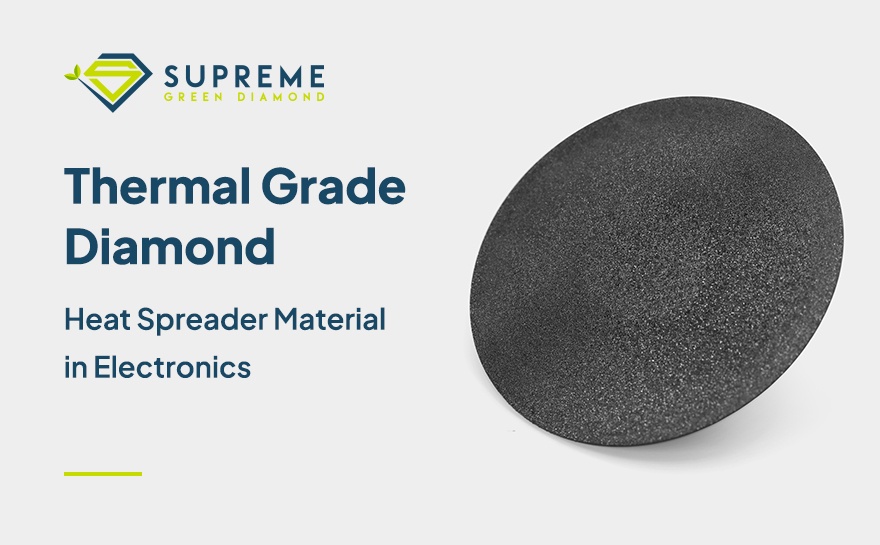Introduction
Modern electronics generate enormous amounts of heat-whether in high-performance computing, power devices, or next-gen communication systems. Efficient heat dissipation is critical to ensure performance, reliability, and longevity. While traditional materials like copper, silicon carbide (SiC), and aluminum nitride (AlN) have been widely used, Thermal Grade Diamond has emerged as the most effective solution.
With its exceptionally high thermal conductivity, diamond is increasingly recognized as the best heat spreader material in advanced electronics.
What Is Thermal Grade Diamond?
Thermal Grade Diamond is a specialized diamond material designed for thermal management in electronics and semiconductor industries. Unlike natural diamonds used for jewelry, these are engineered for performance and stability, delivering unmatched heat dissipation without compromising electrical insulation.
Key advantages include:
- Ultra-high thermal conductivity (up to 2000 W/mK)
- Excellent mechanical strength
- Electrical insulation for sensitive devices
- Chemical stability in demanding environments
Why Diamond Excels as a Heat Spreader
1. Thermal Diamond Heat Spreader Performance
Diamond’s thermal conductivity is 5x higher than copper and far superior to most semiconductor materials. This allows devices like laser diodes, RF amplifiers, and AI chips to stay cooler, enhancing performance and lifespan.
2. Diamond for Cooling High-Power Devices
As devices shrink in size but demand higher power, traditional cooling methods struggle. Diamond for cooling ensures precise and rapid heat dissipation, especially in power electronics, aerospace, and telecom systems.
3. Reliability in Extreme Conditions
Unlike metals that oxidize or ceramics that crack, thermal grade diamond withstands extreme environments, making it ideal for space missions, 6G networks, and defense systems.
Diamond vs Copper, SiC, and AlN: A Comparison
| Property | Diamond | Copper (Cu) | Silicon Carbide (SiC) | Aluminum Nitride (AlN) |
| Thermal Conductivity (W/mK) | ~2000 | ~400 | ~370 | ~180 |
| Electrical Conductivity | Insulator | Conductor | Semiconductor | Insulator |
| Mechanical Strength | Very High | Moderate | High | Moderate |
| Oxidation Resistance | Excellent | Poor | Good | Good |
| Applications | HPC, lasers, RF, aerospace | General heat sinks | Power electronics, wafers | Mid-range electronics |
Verdict: While copper, SiC, and AlN remain common, Thermal Grade Diamond offers unmatched performance, particularly where ultra-high thermal conductivity and reliability are required.
Applications of Thermal Grade Diamond
- Semiconductor devices: Power transistors, high-frequency ICs
- Optoelectronics: Laser diodes, LEDs
- Telecom & 6G networks: Base stations, RF amplifiers
- Defense & aerospace: Radars, satellites, space electronics
- AI & HPC systems: GPUs, quantum processors
Future of Diamond Thermal Management
As AI workloads, 6G communications, and renewable energy demand more efficient systems, thermal grade diamond is expected to dominate the global heat spreader market. Research institutions and industries are already shifting from copper and ceramics to diamond-based cooling for long-term scalability.
Conclusion
In the race to build faster, smaller, and more reliable electronics, Thermal Grade Diamond stands out as the best heat spreader material. With its superior thermal conductivity, stability, and mechanical strength, it outperforms copper, SiC, and AlN, making it the future of thermal management in electronics.
Explore more about Thermal Grade Diamond and how it can transform your next project.
Frequently Asked Questions (FAQs)
Q1. Why is diamond the best heat spreader material?
Diamond offers the highest thermal conductivity (~2000 W/mK), far exceeding copper, SiC, and AlN, making it the most effective material for heat dissipation.
Q2. What is the thermal conductivity of diamond compared to copper?
Diamond: ~2000 W/mK
Copper: ~400 W/mK
This means diamond is about 5 times more efficient in conducting heat.
Q3. Where is thermal grade diamond used?
It is widely used in semiconductors, AI chips, laser diodes, aerospace electronics, and defense systems.
Q4. Is thermal grade diamond electrically conductive?
No. Unlike copper, diamond is an electrical insulator, making it safe for sensitive electronic components.
Q5. Can diamond heat spreaders replace copper completely?
While not cost-effective for all devices, diamond is the preferred choice for high-performance and mission-critical electronics where reliability is essential.

